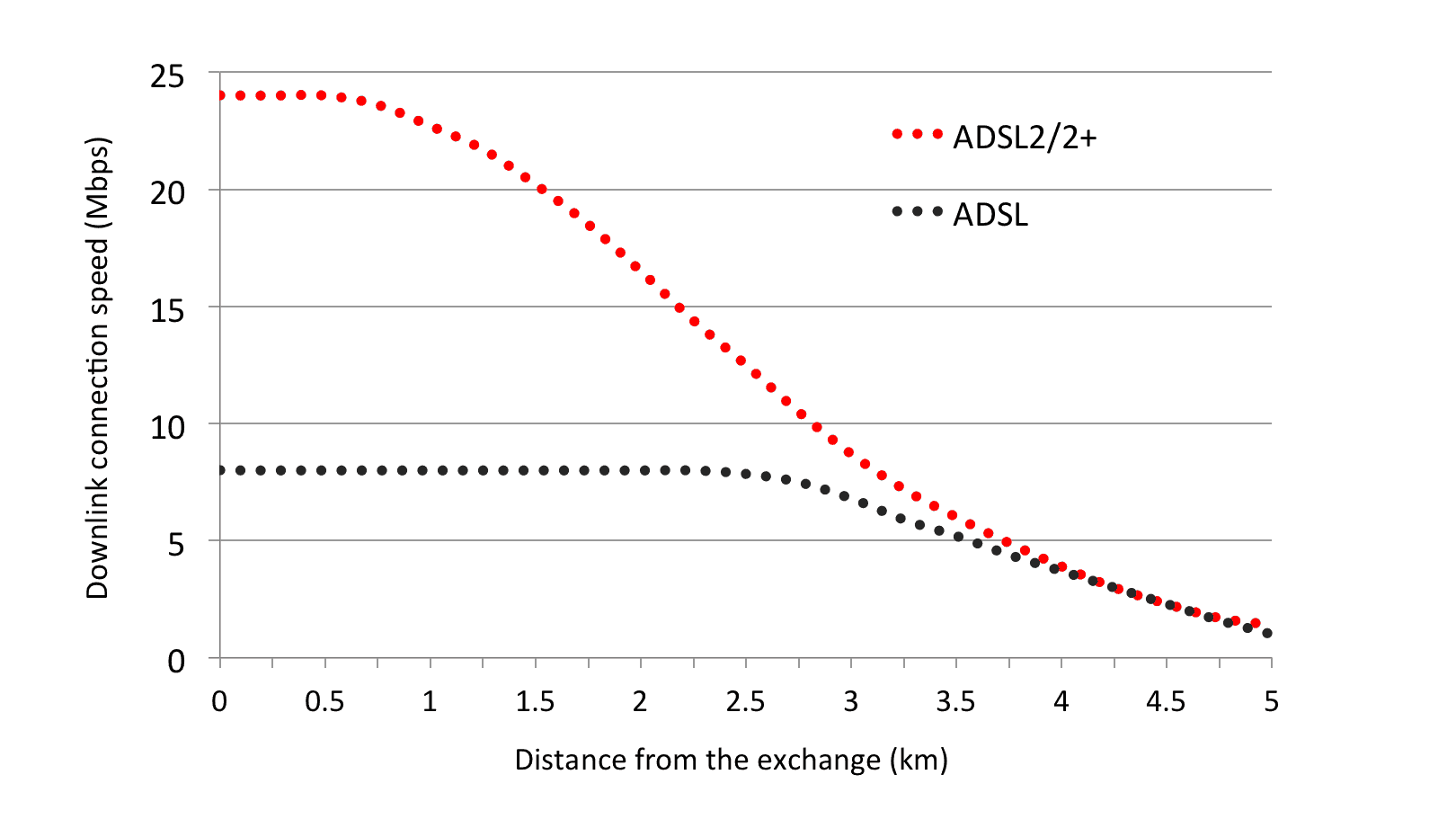In the absence of fibre broadband, opt for an ADSL2+ service if available to you (in preference to basic ADSL broadband), since ADSL2+ offers superior speeds.
BT originally launched broadband services in 2000, using ADSL technology. BT claims ADSL broadband is now available at exchanges serving 99.8% of all UK homes and businesses.
BT has been rolling out new broadband equipment in exchanges (termed ’21CN’), which can use more modern ADSL2+ and ADSL2 modulation technology. ADSL2+ and ADSL2 are enhancements to the original ADSL modulation technology and we strongly recommend that you opt for an ADSL2+ service if it available from your exchange. BT extended its ADSL2+ coverage to over 92% of UK premises by summer 2013. ADSL2+ is now available to 98% of UK homes and businesses.
As shown in the chart below, ADSL2+ delivers higher data rates (up to 24 Mbps) for premises relatively close to the BT exchange by utilising a greater frequency band than ADSL. Sometimes, ADSL2+ is more susceptible to noise and interference on long lines due to the fact that a greater frequency band is used. For challenging lines, a variant called ADSL2 (which uses the same frequency band as ADSL) can provide better reliability, and can be selected by the modem on ADSL2+ lines automatically or manually.

Chart of ADSL2/2+ and ADSL connection speed against distance from the exchange
We strongly recommend opting for an ADSL2+ service over conventional ADSL for a number of reasons:
- it can provide superior downlink connection speeds (as shown in the speed chart above), particularly if you are located close to your exchange
- it can deliver significantly higher upload speeds (close to 1 Mbps or above) compared with 448 kbps for conventional consumer ADSL services
- the gap between connection (sync) speeds and actual throughput can be significantly lower
- BT’s Digital Line Management is much better than with ADSL, being more responsive to improved line conditions.
For distances of 3 km and less from the BT exchange, ADSL2+ delivers significant improvements in downlink data rates.
The relatively low upload speed with a conventional consumer ADSL service (448 kbps) can be frustrating, making uploads of files and photographs slow. The improved upload speeds achieved by ADSL2+ (and ADSL2) are of real benefit. In many cases, at least double the upload speed is achieved. Even premises located a significant distance from the BT exchange should experience significant upload speed improvements.
Also, BT’s implementation of its ADSL2+ service avoids the substantial gap between connection speed and real throughput than can occur with its ADSL service. So, for a 5088 kbps connection speed connection, the maximum throughput would be nearly 4.5 Mbps for ADSL2+, which is about 0.5 Mbps higher than with ADSL.
Finally, BT has significantly improved its Digital Line Management for ADSL2+ services. With ADSL, if your line experiences drop-outs, your IP/bRAS Profile does not automatically increase if you re-sync at a higher speed. If your line experiences significant interference at certain times of the day, which causes your ADSL line to drop, then your modem may connect at a much lower sync speed than normal. Any drop in sync speed is quickly followed by a drop in the IP/bRAS Profile. However, if the modem then resyncs at a much higher speed, then the IP/bRAS Profile is not increased, typically for a period of 48 to 72 hours (and sometimes longer). With an ADSL2+ service, the system responds far more quickly to changes (particularly improvements) in line conditions to ensure that the highest throughputs are being achieved.
There is much misinformation on the Internet about ADSL2+, and some even recommend NOT opting for an ADSL2+ connection if you have a long line as it can potentially result in line instability. This recommendation is fundamentally flawed. Whatever type of line you have, opting for an ADSL2+ service is always the best option. Firstly, uplink speeds are substantially improved. Secondly, the difference between throughput speed and connection (sync) speed is minimised, meaning that you would achieve higher throughputs even for the same connection speed. Thirdly, it is easy to configure a modem to use any of the available transmission modes on an ADSL2+ connection, which include ADSL2 and basic ADSL (also known as G.DMT). We recommend trying all the different modes available to ascertain which one delivers the best combination of connection speed and reliability.
It is important to note that, despite the fact that you may be connected to an ADSL2-enabled exchange, you may still have an ADSL connection. Indeed, we understand that BT may provide ADSL connections to new BT Broadband customers in ADSL2+ enabled exchanges if predicted download speeds are below 8 Mbps. It is, therefore, important to contact your ISP to request an upgrade. This can be very challenging for BT Broadband customers using traditional telephone customer support, as many customer service representatives will not understand what you are talking about! We recommend that BT customers make a request via the BTCare Community Forum (link below), which is the most effective way to be upgraded.
http://community.bt.com/t5/BB-Speed-Connection-Issues/bd-p/BBinHome
